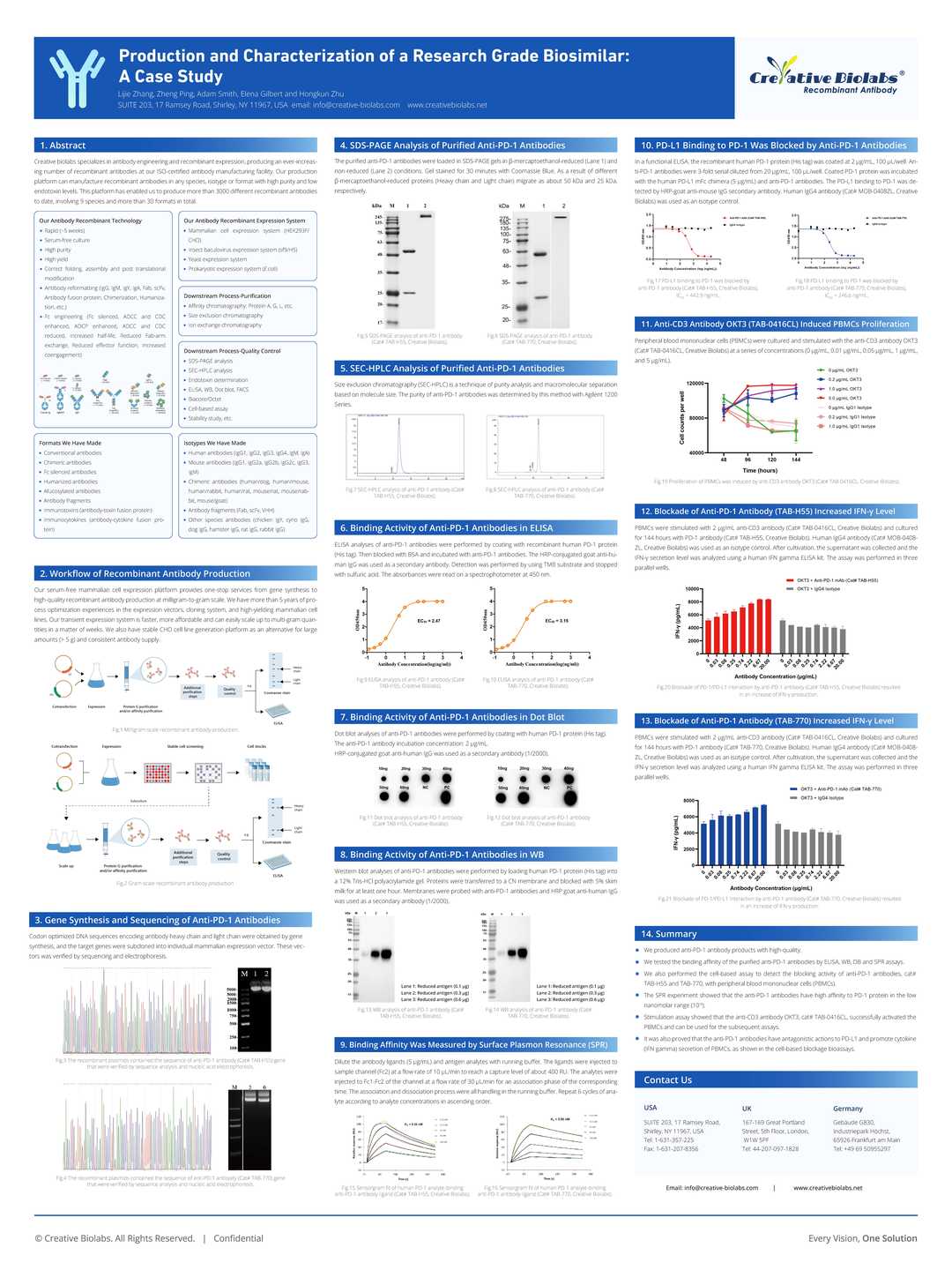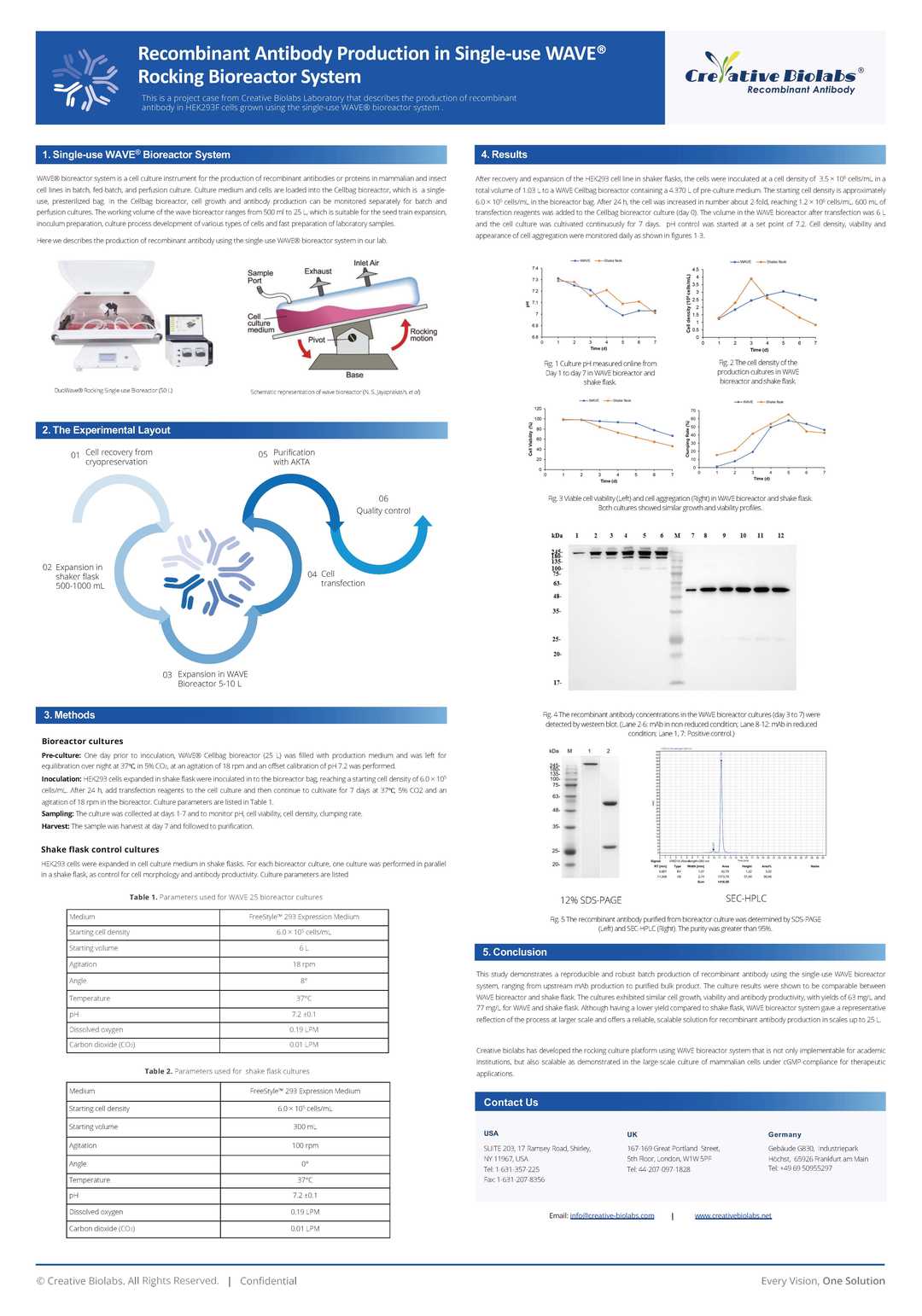Anti-Human MUC1 Recombinant Antibody Fab Fragment (TAB-037-F(E))
CAT#: TAB-037-F(E)
Recombinant antibody Fab to MUC1. This is a humanized monoclonal antibody designed for the treatment of pancreatic cancer. The antibody itself, clivatuzumab, is conjugated with tetraxetan, a chelator for yttrium-90, a radioisotope which destroys the tumour cells.









Specifications
- Immunogen
- The details of the immunogen for this antibody are not available.
- Host Species
- Mouse
- Derivation
- Humanized (from mouse)
- Type
- Fab - G1 - kappa
- Specificity
- Tested positive against native human antigen.
- Species Reactivity
- Human
- Applications
- Neut, ELISA, IF, IP, FuncS, FC, IHC, Activ, WB, Inhib
- MW
- 145,723.71 g/mol
Product Property
- Purity
- >95.0% as determined by analysis by RP-HPLC.
- Storage
- At -20°C for one year.
Applications
- Application Notes
- The MUC1 antibody has been reported in applications of Neut, ELISA, IF, IP, FuncS, FC, IHC, Activ, WB, Inhib.
Target
- Alternative Names
- Mucin 1, Cell Surface Associated; Tumor-Associated Epithelial Membrane Antigen; Breast Carcinoma-Associated Antigen DF3; Peanut-Reactive Urinary Mucin; Polymorphic Epithelial Mucin; Carcinoma-Associated Mucin; Mucin 1, Transmembrane; Krebs Von Den Lungen-6; Cancer Antigen 15-3; Episialin; CA 15-3; H23AG; MUC-1; KL-6; PEMT; EMA; PUM; PEM
- Gene ID
- 4582
- UniProt ID
- P15941
Customer Review
There are currently no Customer reviews or questions for TAB-037-F(E). Click the button above to contact us or submit your feedback about this product.
Submit Your Publication
Published with our product? Submit your paper and receive a 10% discount on your next order! Share your research to earn exclusive rewards.
Downloadable Resources
Download resources about recombinant antibody development and antibody engineering to boost your research.
Product Notes
This is a product of Creative Biolabs' Hi-Affi™ recombinant antibody portfolio, which has several benefits including:
• Increased sensitivity
• Confirmed specificity
• High repeatability
• Excellent batch-to-batch consistency
• Sustainable supply
• Animal-free production
See more details about Hi-Affi™ recombinant antibody benefits.
Datasheet
MSDS
COA
Certificate of Analysis LookupTo download a Certificate of Analysis, please enter a lot number in the search box below. Note: Certificate of Analysis not available for kit components.
Protocol & Troubleshooting
We have outlined the assay protocols, covering reagents, solutions, procedures, and troubleshooting tips for common issues in order to better assist clients in conducting experiments with our products. View the full list of Protocol & Troubleshooting.
See other products for "MUC1"
Select a product category from the dropdown menu below to view related products.
| CAT | Product Name | Application | Type |
|---|---|---|---|
| NAB-2049-VHH | Recombinant Anti-human MUC1 VHH Single Domain Antibody | WB, IP, ChiP, Neut, ELISA | Llama VHH |
| HPAB-AP504-YC | Recombinant Camel Anti-MUC1 Single Domain Antibody (HPAB-AP504-YC) | FC | Camel VHH |
| HPAB-AP505-YC | Recombinant Camel Anti-MUC1 Single Domain Antibody (HPAB-AP505-YC) | ELISA | Camel VHH |
| HPAB-0736-YJ-VHH | Camelid Anti-MUC1 Recombinant Single Domain Antibody (HPAB-0736-YJ-VHH) | ELISA | Camelid VHH |
| HPAB-0737-YJ-VHH | Camelid Anti-MUC1 Recombinant Single Domain Antibody (HPAB-0737-YJ-VHH) | ELISA | Camelid VHH |
| CAT | Product Name | Application | Type |
|---|---|---|---|
| MOB-1077z | Mouse Anti-MUC1 Recombinant Antibody (clone 18C4) | WB, FC, IF, IHC | Mouse IgG1, κ |
| PABL-662 | Mouse Anti-MUC1 Recombinant Antibody | WB, IF, FuncS | Mouse IgG |
| MOB-0364MZ | Recombinant Mouse Anti-Human Mucin 1, Cell Surface Associated, FITC-Conjugated Antibody (clone Cer-EP5) | ELISA | Mouse antibody |
| HPAB-0091-YC | Mouse Anti-MUC1 Recombinant Antibody (HPAB-0091-YC) | ELISA, Neut | Mouse IgG |
| HPAB-0094-YC | Mouse Anti-MUC1 Recombinant Antibody (clone 12D10) | ELISA, FC | Mouse IgG2a |
| CAT | Product Name | Application | Type |
|---|---|---|---|
| TAB-173 | Anti-Human MUC1 Recombinant Antibody (TAB-173) | IF, IP, Neut, FuncS, ELISA, FC, ICC | IgG1 - kappa |
| TAB-H65 | Anti-Human MUC1 Recombinant Antibody (Sontuzumab) | WB, ELISA, FC, IP, FuncS, IF, Neut | IgG1 |
| TAB-166 | Humanized Anti-MUC1 Recombinant Antibody (clone Cantuzumab) | IP, IF, FuncS, FC, Neut, ELISA, ICC | Humanized (from mouse) IgG1, κ |
| TAB-H77 | Human Anti-MUC1 Recombinant Antibody (TAB-H77) | FuncS, Inhib | IgG1, κ |
| TAB-413MZ | Human Anti-MUC1 Recombinant Antibody (TAB-413MZ) | ELISA | Humanized IgG |
| CAT | Product Name | Application | Type |
|---|---|---|---|
| TAB-H56 | Anti-Human MUC1 Recombinant Antibody (Pemtumomab) | WB, FuncS, IF, Neut, ELISA, FC, IP | IgG |
| TAB-765 | Mouse Anti-MUC1 Recombinant Antibody (clone Nacolomab); Fab Fragment | FC, IP, ELISA, Neut, FuncS, IF, ICC | Mouse Fab (IgG1, κ) |
| TAB-0388CL | Mouse Anti-Human MUC1 Recombinant Antibody | WB, IHC | |
| TAB-0388CL-S(P) | Mouse Anti-Human MUC1 Recombinant Antibody scFv Fragment | WB, IHC | |
| TAB-0388CL-F(E) | Mouse Anti-Human MUC1 Recombinant Antibody Fab Fragment | WB, IHC |
| CAT | Product Name | Application | Type |
|---|---|---|---|
| AGTO-L036E | anti-MUC1 immunotoxin C242 (Fab)-PE | Cytotoxicity assay, Functional assay | |
| AGTO-L064E | anti-MUC1 immunotoxin H23 (scFv)-PE | Cytotoxicity assay, Functional assay |
| CAT | Product Name | Application | Type |
|---|---|---|---|
| PFBL-656 | Mouse Anti-MUC1 Recombinant Antibody; Fab Fragment | WB, IF, FuncS | Mouse Fab |
| HPAB-0091-YC-F(E) | Mouse Anti-MUC1 Recombinant Antibody; Fab Fragment (HPAB-0091-YC-F(E)) | ELISA, Neut | Mouse Fab |
| HPAB-0094-YC-F(E) | Mouse Anti-MUC1 Recombinant Antibody (clone 12D10); Fab Fragment | ELISA, FC | Mouse Fab |
| FAMAB-0225-YC-F(E) | Mouse Anti-MUC1 Recombinant Antibody (clone MUSE11); Fab Fragment | IHC | Mouse Fab |
| HPAB-0670-CN-F(E) | Human Anti-MUC1 Recombinant Antibody; Fab Fragment (HPAB-0670-CN-F(E)) | FC | Human Fab |
| CAT | Product Name | Application | Type |
|---|---|---|---|
| PSBL-656 | Mouse Anti-MUC1 Recombinant Antibody; scFv Fragment | WB, IF, FuncS | Mouse scFv |
| HPAB-0091-YC-S(P) | Mouse Anti-MUC1 Recombinant Antibody; scFv Fragment (HPAB-0091-YC-S(P)) | ELISA, Neut | Mouse scFv |
| HPAB-0094-YC-S(P) | Mouse Anti-MUC1 Recombinant Antibody (clone 12D10); scFv Fragment | ELISA, FC | Mouse scFv |
| FAMAB-0225-YC-S(P) | Mouse Anti-MUC1 Recombinant Antibody (clone MUSE11); scFv Fragment | IHC | Mouse scFv |
| HPAB-0670-CN-S(P) | Human Anti-MUC1 Recombinant Antibody; scFv Fragment (HPAB-0670-CN-S(P)) | FC | Human scFv |
| CAT | Product Name | Application | Type |
|---|---|---|---|
| TAB-0278CL | Human Anti-MUC1 Recombinant Antibody (TAB-0278CL) | ELISA, Internalization, BI, FuncS | Human IgG |
| TAB-0278CL-S(P) | Human Anti-MUC1 Recombinant Antibody; scFv Fragment (TAB-0278CL-S(P)) | ELISA, Internalization, BI, FuncS | Human scFv |
| TAB-0278CL-F(E) | Human Anti-MUC1 Recombinant Antibody; Fab Fragment (TAB-0278CL-F(E)) | ELISA, Internalization, BI, FuncS | Human Fab |
| TAB-431MZ | Anti-Human MUC1 Recombinant Antibody (PH1) | ELISA, WB, FC, IHC, SPR | Human antibody |
| TAB-432MZ | Human Anti-MUC1 Recombinant Antibody (TAB-432MZ) | ELISA, FC, FACS, DB, SPR | Human IgG |
| CAT | Product Name | Application | Type |
|---|---|---|---|
| TAB-412MZ | Human Anti-MUC1 Recombinant Antibody (TAB-412MZ) | ELISA | Chimeric (mouse/human) IgG |
| TAB-412MZ-S(P) | Mouse Anti-MUC1 Recombinant Antibody; scFv Fragment (TAB-412MZ-S(P)) | ELISA | Mouse scFv |
| TAB-412MZ-F(E) | Human Anti-MUC1 Recombinant Antibody; Fab Fragment (TAB-412MZ-F(E)) | ELISA | Chimeric (mouse/human) Fab |
| CAT | Product Name | Application | Type |
|---|---|---|---|
| Gly-012LC | Recombinant Anti-Human MUC1 Antibody (Fab glycosylation/Sialylated) | ELISA, FC, IHC | Humanized antibody |
| Gly-120LC | Recombinant Anti-Human MUC1 Antibody (Fab glycosylation) | ELISA | Mouse antibody |
| CAT | Product Name | Application | Type |
|---|---|---|---|
| Gly-012LC-1 | Recombinant Anti-Human MUC1 Antibody (Fab glycosylation/Sialylated) | ELISA, FC, IHC | Humanized antibody |
| CAT | Product Name | Application | Type |
|---|---|---|---|
| Gly-109LC | Recombinant Anti-Human MUC1 Antibody (Fc glycosylation) | ELISA | Human antibody |
| CAT | Product Name | Application | Type |
|---|---|---|---|
| Gly-121LC | Recombinant Anti-Human MUC1 Antibody (Non-glycosylated) | ELISA | Mouse antibody |
| Gly-122LC | Recombinant Anti-Human MUC1 Antibody (Non-glycosylated) | ELISA | Mouse antibody |
| Gly-124LC | Recombinant Anti-Human MUC1 Antibody (Non-glycosylated) | ELISA | Mouse antibody |
| CAT | Product Name | Application | Type |
|---|---|---|---|
| BRD-0379MZ | Chicken Anti-MUC1 Polyclonal IgY | IHC, WB | Chicken antibody |
| CAT | Product Name | Application | Type |
|---|---|---|---|
| MOR-2320 | Hi-Affi™ Recombinant Rabbit Anti-MUC1 Monoclonal Antibody (DS2320AB) | IHC-P, IHC-Fr | IgG |
| CAT | Product Name | Application | Type |
|---|---|---|---|
| EPAF-0838LC | Recombinant Mouse Anti-Human MUC1 Antibody (SM3) | ELISA | IgG1 |
| EPAF-0581CQ | Recombinant Mouse Anti-Human MUC1 Antibody (B27.29) | Neut, FC | IgG1 |
| EPAF-0583CQ | Recombinant Mouse Anti-Human MUC1 Antibody (BC4E549) | Neut, FC | IgG1 |
| EPAF-0584CQ | Recombinant Mouse Anti-Human MUC1 Antibody (DF3) | Neut, FC | IgG1 |
| CAT | Product Name | Application | Type |
|---|---|---|---|
| AFC-TAB-H56 | Afuco™ Anti-MUC1 ADCC Recombinant Antibody, ADCC Enhanced (AFC-TAB-H56) | FuncS, IF, Neut, ELISA, FC | ADCC enhanced antibody |
| AFC-TAB-H65 | Afuco™ Anti-MUC1 ADCC Recombinant Antibody, ADCC Enhanced (AFC-TAB-H65) | ELISA, FC, IP, FuncS, IF | ADCC enhanced antibody |
| AFC-TAB-026ML | Afuco™ Anti-MUC1 ADCC Recombinant Antibody, ADCC Enhanced (AFC-TAB-026ML) | ELISA, IHC, FC, IP, IF, FuncS | ADCC enhanced antibody |
| AFC-TAB-166 | Afuco™ Anti-MUC1 ADCC Recombinant Antibody, ADCC Enhanced (AFC-TAB-166) | IP, IF, FuncS, FC, Neut, ELISA | ADCC enhanced antibody |
| AFC-TAB-H77 | Afuco™ Human Anti-MUC1 Recombinant Antibody, ADCC Enhanced (AFC-TAB-H77) | ELISA, FC, IP, FuncS, IF | IgG1, κ |
| CAT | Product Name | Application | Type |
|---|---|---|---|
| HPAB-AP745-YC | Mouse Anti-MUC1 Recombinant Antibody (HPAB-AP745-YC) | ELISA | Mouse IgM |
| CAT | Product Name | Application | Type |
|---|---|---|---|
| VS-0424-XY192 | AbPlus™ Anti-MUC1 Magnetic Beads (139H2) | IP, Protein Purification | |
| VS-0724-YC1494 | AbPlus™ Anti-MUC1 Magnetic Beads (VS-0724-YC1494) | IP, Protein Purification |
| CAT | Product Name | Application | Type |
|---|---|---|---|
| VS-0125-FY26 | Human Anti-MUC1 (clone 1B2) scFv-Fc Chimera | FC | Human IgG1, scFv-Fc |
| CAT | Product Name | Application | Type |
|---|---|---|---|
| VS-0225-XY169 | CytoStream™ Mouse Anti-MUC1 Recombinant Antibody (VS-0225-XY169) | FC | Mouse IgG1, kappa |
| CAT | Product Name | Application | Type |
|---|---|---|---|
| VS-0325-XY1394 | Anti-MUC1 Immunohistochemistry Kit | IHC | |
| VS-0525-XY4575 | Anti-Human MUC1 Immunohistochemistry Kit | IHC | |
| VS-0525-XY4576 | Anti-Mouse MUC1 Immunohistochemistry Kit | IHC |
| CAT | Product Name | Application | Type |
|---|---|---|---|
| VS-0425-YC379 | Recombinant Anti-MUC1 Vesicular Antibody, EV Displayed (VS-0425-YC379) | ELISA, FC, Neut, Cell-uptake |
| CAT | Product Name | Application | Type |
|---|---|---|---|
| VS-0525-YC131 | Recombinant Anti-MUC1 Biparatopic Antibody, Tandem scFv | ELISA, IHC | Tandem scFv |
| CAT | Product Name | Application | Type |
|---|---|---|---|
| VS-0825-YC261 | SmartAb™ Recombinant Anti-MUC1 pH-dependent Antibody (VS-0825-YC261) | ELISA, IHC, Inhib | Human IgG kappa |
Popular Products

Application: ELISA, FC, IP, FuncS, IF, Neut, ICC

Application: IF, IP, Neut, FuncS, ELISA, FC, ICC

Application: FC, IB, Block, Inhib, FuncS, ELISA, FACS, IP, IF

Application: ELISA, FC, WB, FuncS
-2.png)
Application: ELISA

Application: ELISA, Inhib, FC, Neut

Application: ELISA, WB
For research use only. Not intended for any clinical use. No products from Creative Biolabs may be resold, modified for resale or used to manufacture commercial products without prior written approval from Creative Biolabs.
This site is protected by reCAPTCHA and the Google Privacy Policy and Terms of Service apply.





























